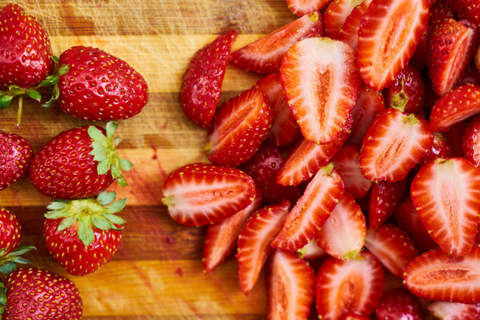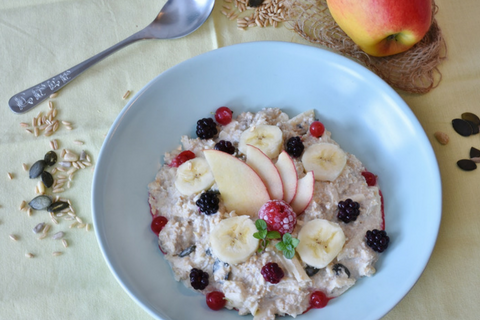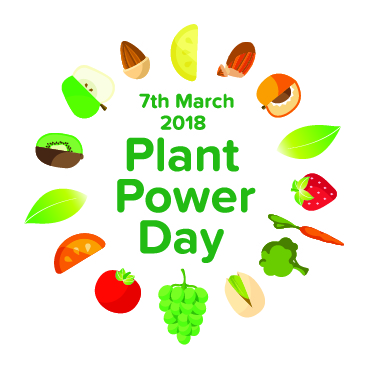
by Tanya HAFFNER | Jun 29, 2018 | Media in context
This month, the British Medical Journal (BMJ) published a review on dietary patterns and chronic disease prevention. It aimed to answer questions including whether specific foods actually provide health benefits; and whether exclusion diets – vegetarian, vegan, avoidance of gluten or lactose – are the key to good health.
Here we put it in the context of the advice we’re being by government as to what we should eat to be healthy.
Key messages from the BMJ review:
- Prioritise eating fruits, vegetables, whole grains and fish to best help prevent chronic disease risk. Equally, lower consumption of red and processed meats and sugar-sweetened drinks.
- Eating more nuts, legumes, vegetable oils, fermented dairy products and coffee are further likely to provide benefit.
- Evidence comes from prospective observational and intervention studies, each study design having different strengths and limitations. Both types of studies should contribute to the evidence base.
- New analytical approaches are still needed for nutrition research.
How do the findings fit in with current advice?
The key messages promoted from the review support the government’s advice for healthy eating, the Eatwell Guide.
- Fruit and vegetables
BMJ: Found that fruit and vegetables were associated with lower risk of cancer, coronary heart disease and stroke.
GUIDANCE: It’s recommended we eat at least five portions of fruit and vegetables per day. See this factsheet (https://www.bda.uk.com/foodfacts/FruitVeg.pdf) from the British Dietetic Association (BDA) on how to help achieve this.
- Whole grains
BMJ: Wholegrain consumption was related to lower risk for most diseases studied (the endpoints).
GUIDANCE: We are advised to have at least 30 grams of fibre per day. Wholegrains can certainly help us achieve this. See the British Dietetic Association fibre fact sheet for more information https://www.bda.uk.com/foodfacts/fibrefoodfactsheet.pdf.
- Fish
BMJ: Fish consumption was found to reduce the risk of coronary heart disease and stroke.
GUIDANCE: The government recommend we consume 2 portions of fish per week (one portion is around 140g), one of which should be oily. Find out more from the National Health Service.
- Red and processed meat
BMJ: Consumption of red and processed meats increased the risk for most of the endpoints.
GUIDANCE: This supports the latest review by the World Cancer Research Fund (WCRF) discussed in our previous blog.
Their report recommends we consume no more than about three portions per week, which is around 350–500g cooked weight (or 525–750g raw weight) a week. To help give you an idea of what that means:
- One pork chop is 75g cooked weight (110g raw)
- One medium steak is 145g (210g raw)
- A portion of beef mince in Bolognese averages about 140g cooked weight (200g raw).
WCRF recommend that for cancer protection we eat little or no processed meats (e.g. sausages, ham, bacon).
- Sugar sweetened drinks
BMJ: Drinking sugar-sweetened drinks was associated with increased risk of type 2 diabetes, coronary heart disease and stroke.
GUIDANCE: Excessive sugar intake (for which sugar-sweetened drinks are a major contributor of) remains a major problem in the UK. Just a couple of months ago, the UK sugar tax was introduced as one of the many strategies employed to help combat this public health issue.
The government’s advice for limiting free sugars supports BMJ’s findings.
- Nuts, fermented dairy products, coffee and others
The review states that higher consumption of nuts, legumes and vegetable oils are likely to confer further benefits. This helps support the benefits behind a more plant-based diet. For more information see the BDA’s factsheet (https://www.bda.uk.com/foodfacts/plant-based_diet).
Fermented dairy products (such as yogurt, kefir) were also mentioned because links were found between these foods and a reduced risk of cardiometabolic disease. Whilst fermented dairy foods can form part of a balanced diet, the research is inconclusive at this stage. The British Nutrition Foundation discuss the area of fermented foods and why it can be difficult to draw conclusions at this stage.
Finally, studies found a reduced risk of many endpoints by drinking 3-5 cups of coffee per day. We often see headlines focusing on negative effects of coffee, when in fact there is a lot of research for beneficial effects.
Coffee can certainly help meet our daily fluid requirements and should not be discouraged. We must bear in mind that due to the caffeine, it should be limited to two cups per day (instant coffee) for pregnant women.
The review also goes through the studies found for specific dietary patterns, highlighting that most reliable evidence for chronic disease prevention lies with following a Mediterranean diet. This type of diet generally refers to a diet encouraging high intake of fruits, nuts and seeds, vegetables, fish, legumes and cereals and reducing intake of meat and dairy products. Moderate intakes of alcohol and olive oil are also components of this diet.
Summary
This latest BMJ review supports the government’s messages for healthy eating. A significant proportion of the foods shown to be of benefit (such as fruit and vegetables, wholegrains, legumes, nuts and vegetable oils) are plant-based and these should be encouraged as part of our whole diets for both health and environmental reasons.
Remember:
– There are often flaws to research in the field of nutrition, as discussed the BMJ review.
– Concentrate on the whole diet rather than just focusing on individual foods or groups.

by Tanya HAFFNER | Mar 18, 2018 | Hot Topics in nutrition, Media in context, The Nation’s Health
Coinciding with Salt Awareness Week, this week the BBC, the Daily Mail, the Independent and many more reported on how high salt content in Chinese takeaway meals from restaurants and supermarkets.
The news follows analysis published by Action on Salt, who are calling for health warnings to be mandatory.
Keep this in mind as you read on: The maximum daily allowance for adults is 6g per day (about one teaspoon).
Here are some of the key points from the study…
Chinese takeaway meals
Six independent restaurants in London’s Chinatown were analysed
- 97% of dishes contained 2g (1/3 of a teaspoon) or more of salt per dish.
- 58% contained more than 3g (1/2 teaspoon) of salt per dish.
- Combining side dishes on top would provide over 6g (over 1 teaspoon – the maximum daily allowance for adults) salt per day.
- The saltiest takeaway main meal with a rice/noodle side dish contained 11.50g of salt (about 2 teaspoons) (Beef in Black Bean Sauce and Vegetable Noodles).
- Variation was seen between the same dishes but from different restaurants. For example, sweet and sour dishes ranged from 1g to 3.4g of salt per portion.
- On average, beef in black bean sauce dishes were the highest in salt (1.27g per 100g) and sweet and sour dishes were the least salty (0.54g per 100g).
Supermarket ready meals
141 ready meals were surveyed
- Nearly half (43%) were high in salt (containing over 1.5g per 100g or over 1.8g salt per portion). These meals would be coded as ‘red’ under salt on the food traffic light labelling system.
- The highest in salt was Slimming World’s Chinese Style Banquet Rice with 4.40g salt (about 2/3 teaspoon salt) per 550g pack.
- As well as main dishes found to be high in salt, side dishes such as rice dishes, spring rolls and prawn crackers could easily tot up the salt levels. One example of Egg Fried Rice (Iceland’s Takeaway Egg Fried Rice) contained 4.1g (2/3 teaspoon) salt per 350g pack. That’s more salt than is in 11 ready salted bags of crisps!
- Variation was apparent, with Tesco’s Egg Fried Rice containing only 0.1g salt per 250g.
For more detailed findings, see the original analysis PDF
Behind the headlines: the Nutrilicious dietetic view
Points to consider
As ever, we need to note any limitations of the report. While the analysis included a large number of supermarket ready meals, the restaurant analysis was only conducted on six restaurants in London Chinatown, so we cannot be confident findings will be the same elsewhere. Plus, it’s clear that salt levels will vary between restaurants and between meals.
That said, UK adults eat around 22 million takeaways each week, with Chinese being the most popular. Judging by these findings, it seems there is an urgent need to drastically cut salt levels in these meals.
Why is too much salt bad for us?
Too much salt can contribute to raised blood pressure, which increases the risk of stroke and heart disease.
In the UK, we are currently eating more salt than is recommended, averaging 8.1g per day (1.3 teaspoons of salt, about a third more than the maximum recommendation). This is largely due to the high amounts of salt hidden in the food we buy, for which this analysis of Chinese meals provides further support.
The good news is this average intake has actually reduced by 15% over the last decade, primarily due to product reformulation. Now we need to go further.
Is the government taking enough action reduce salt?
- Public Health England have been encouraging the food industry to cut salt levels in food. However, so far there has been little action, with no progress report on whether the last set of salt targets (due to have been met by the end of 2017) have been reached, nor any plans to set new targets.
- As part of this 19th Salt Awareness Week, Action on Salt are calling on Public Health England for immediate action – they want to focus on setting new salt targets, making front of pack labelling mandatory and would like to see warning labels on menus for dishes high in salt. More action is needed from the food industry and the out of home sector to reduce the amount of salt added, and to provide us with healthier choices lower in salt.
- This week, Action on Salt are hosting a Parliamentary Reception at the House of Commons to discuss the future of salt reduction in the UK, with attendees from the Department of Health, Non-Governmental Organisations (NGOs) and the food industry.
Sonia Pombo, Campaign Manager for Action on Salt stated: “Our data shows that food can be easily reformulated with lower levels of salt, so why haven’t all companies acted responsibly? The lack of front-of-pack colour coded labelling on branded products makes it incredibly difficult for consumers to make healthier choices and that is simply unacceptable.”
What can we do to keep our salt intakes low?
Food industry, including all food service providers
All responsible food providers should by now be carrying out at least a six-monthly nutrition and health check on their products and/or recipes, which includes the traffic light coding in order to highlight which ones need to be placed into a programme for reformulation.
At Nutrilicious, we have enjoyed helping numerous food service providers and manufacturers with this ongoing check along with nutrition and advice for ongoing product reformulation and development. If your company or organisation products or recipes need a nutrition and health check we would be delighted to help.
Taking personal responsibility
We should all be keeping salt to a minimum in our diets. For tips and advice on how to do this see:
Clearly, reducing intake of pre-packaged foods and takeaways is important for reducing salt intake, as shown in this analysis.
In the case for ready-made foods, being aware of what the labels mean can help with making wiser choices. For salt, a product is considered high in salt if it contains more than 1.8g salt per portion or if it is over 1.5g salt per 100g of the product.
Takeaway messages
This analysis highlights that salt levels can be extremely high in Chinese takeaway meals and supermarket ready meals. The relevance of reducing salt intake is paramount; each 1g reduction in daily salt intake prevents 7,000 deaths, 4,000 of which are premature, from strokes and heart disease.
We are pleased to see Action on Salt calling on Public Health England to take more action in this issue. Key messages for healthy eating apply to us all: eat a balanced diet, with plenty of fruit and vegetables, wholegrains and less processed foods and takeaways. This can help lower not only salt, but also sugar, fats and saturated fats; all of which in too high amounts can have negative health effects.
Following this advice – alongside other healthy lifestyle decisions such as keeping physically active – can help keep us in good health and reduce the chances of developing negative health effects such as obesity, heart disease and cancer.

by Tanya HAFFNER | Mar 9, 2018 | Retail, Hot Topics in nutrition, Media in context, The Nation’s Health, Catering/Out of Home
This week, Public Health England published a new report into calorie consumption, calling on food makers to cut calories in the products to help in the combat against obesity. The findings were discussed by the BBC, the Daily Mail and the Guardian, among many others.
Key points of the report include:
- New evidence highlighting overweight or obese boys and girls consume up to 500 and 290 calories too many each day respectively
- A challenge to the food industry to reduce calories in products consumed by families by 20% by 2024
- This will include 13 types of savoury, processed foods such as pizzas, ready meals, ready-made sandwiches, meat products and savoury snacks.
- Food companies can achieve this by either 1) reducing portion sizes, 2) reformulation of products or 3) signposting to lower calorie options already available.
According to PHE, “If the 20% target is met within 5 years, more than 35,000 premature deaths could be prevented and around £9 billion in NHS healthcare and social care costs could be saved over a 25 year period.”
Alongside the report comes the launch of the One You campaign, encouraging adults to consume 400 calories at breakfast, and 600 each for lunch and dinner, plus a couple of healthy snacks in between. This comes as adults consume 200 to 300 calories in excess each day.
- Major high street brands are partnering with PHE on the campaign (including Greggs, Starbucks, McDonalds and Subway), helping show consumers which meals can meet the 400-600-600kcal mark. Total daily calorie intake recommendations remain at 2,000kcal for women and 2,500kcal for men.
- The Only You Easy Meals app gives ideas for what could fit into this (also see our examples listed further below).
This new plan from the Government comes on top of the sugar levy which comes into force next month and the sugar reduction programme. Read more about both here
Behind the headlines: the Nutrilicious dietetic view
The battle against being overweight or obese is an important one:
- In the UK, two thirds of adults and one third of children are classed as ‘overweight’ (Body Mass Index over 25kg/m2) or ‘obese’ (Body Mass Index over 30kg/m2).
- Overweight and obesity can have a serious impact on health and increase the risk of:
- Type 2 diabetes
- Musculoskeletal disorders (like osteroarthritis)
- Cardiovascular disease
- Some types of cancer (such as breast cancer, endometrial and bowel cancer)
- Psychological problems
Source: World Health Organisation
While we hope the new plan by the government will help with the obesity battle, there are some points to consider when going through the plans:
- Cutting foods by 20% in calories – This is a voluntary target and so unfortunately there is no guarantee food companies will actually respond to these targets. However, PHE have stated that if there is little response, they will ‘name and shame’ the brands that are not co-operating and they would then consider asking the Government to legislate.
- The 400-600-600 tip
This could be a useful way to help people stay more on track at mealtimes; it is simple approach and easy to remember. Here are a here are a few examples from the Only You App
|
400kcal breakfast
|
600kcal lunch |
600kcal dinner |
| Banana porridge made with milk and oats with raspberry mash |
Beans on wholegrain toast with mushrooms, tomatoes and peppers |
Chicken and vegetable parcels with noodles or potatoes |
| Traffic light omelettes with mixed peppers |
Salmon and cucumber wholewheat wraps with watercress
|
Lentil and vegetable cobbler |
| Toasted oats with yogurt, apple and grapes |
Wholegrain pitta pizza with with mushrooms, tomatoes and light mozzarella |
New potato and tuna salad |
However, while it’s suggested just as a guide, men require more calories than women… is it appropriate to apply such advice to both? Using the 400-600-600 calorie rules, this would leave men with 900 calories left within their recommended daily allowance for snacks. Would you say this was the best approach?The “guide” element in our view will need to be emphasised much more in the communications.
- Nutrient intake
It’s good to be calorie aware and know rough guides, but sometimes the higher calorie option could be healthier than the lower calorie option. What calorie counting does not do is consider nutrient intake of a meal nor the balance of different foods in a meal, which is a major drawback of the approach.
To give a breakfast example, a white bacon roll (about 290 calories) offers little beneficial nutrition but could come in at lower calories than a bowl of porridge topped with a piece of sliced fruit and a handful of nuts (about 400 calories). The latter offers a healthier source of protein and fats from the nuts compared to processed meat, plus a portion of fruit. The porridge would help contribute to our fibre much more than the roll – and in the UK, the current average fibre intake needs to increased by 60% to be meeting the UK recommendations.
So while we may reduce calorie consumption, we may then lose something else that is good for our health (e.g. fibre). The approach in fact has the potential to be counterproductive if we choose a meal that is lower in quality, causing excess snacking if, for example, you didn’t have enough fibre in the meal to fill you up.
It’s great that the supporting app and website help teach more about healthy choices; hopefully those who decide to follow 400-600-600 will take the advice on board. It will be important for PHE to monitor the uptake and how healthy the choices will be and for us as public health advisers to be aware of these results.
- There is the suggestion and worry that such rules with calories could create unhealthy relationships with food for some.
- Finally there is no magic bullet to the obesity crisis. It continues to require large scale urgent multi-pronged approaches to be overcome and we must not loose sight of this which know from unanimous research including the game changing McKinsey Global Institute Report on overcoming obesity, that has yet to be truly taken on board by any overweight nation.
Takeaway message
This is an important new report and initiative from Public Health England which overall we welcome and hope alongside other initiatives already started as well as those yet to come will help to make a difference to the current obesity crisis. We look forward to supporting the initiative in the context of what is also eaten in our communications alongside other strategies dependent on the audiences that we are influencing. In the meantime we also hope that this initiative will be communicated and closely measured by PHE in the context of the above concerns as WHAT we eat is of great value to our overall health and weight, not just how much we eat.

by Tanya HAFFNER | Mar 7, 2018 | Hot Topics in nutrition, Food category comment, Media in context, Education, Resources worth having
Below is a Press Release from the Alpro Science & Nutrition Team this week which we felt was worth sharing as it highlights a new and extensive review on the nutrition of plant-based drinks addressing a number of nutritional misconceptions.
PRESS RELEASE: 7TH March 2018
THE DEBATE OVER THE POWER OF PLANT-BASED DRINKS:
PUTTING THE MISCONCEPTIONS TO BED
7th March 2018: The debate on the benefits of plant-based eating, including plant-based drinks, is a hot topic with opposing messages from supporters and sceptics on the quality and quantity of protein, vitamins and minerals, and their role within the government’s Eatwell Guide. Hardly surprising then that the subject of plant power and placing plant foods first get regular column inches focusing on everything from the environment to health and, of course, the government guidance perspective.
So what is the truth and how confident can you be in championing plant foods to consumers?
Well, the good news is that consumers have already come to the smart conclusion and are considering plant power more and more in their diets. In fact, a plant based white paper, authored to celebrate this week’s Plant Power Day on 7th March, shows that more than half of UK shoppers say they are planning or considering adding more plant-based food and drink into their diets over the next year, with, health, weight loss and the environment being the biggest motivators for buying plant-based.1
One of the most accessible ways of doing this, is through the consumption of plant-based drinks, the production of which makes more efficient use of the earth’s resources using less land, water and produces fewer greenhouse gas emissions than dairy. They are, in the main, low in saturated fats, which is good news for heart health (heart disease remains UK’s no.1 killer) and the fortified drinks provide important nutrients for bone health: calcium and vitamin D.*
But, never one to sit smugly on our laurels, to resolve any continuing misconceptions around plant-based drinks and plant-based eating, Vanessa Clarkson, independent expert, registered dietitian and nutritionist, was invited to take a deep dive into the scientific evidence and provide a balanced critique of the role of plant-based drinks in the UK diet.
The evidence was vast (over 60 of the most up to date publications were reviewed) resulting in the production of an 8-page review fact sheet. The conclusion clearly indicates that plant-powered drinks should be on everyone’s shopping list alongside an array of other healthful plant-based foods.2
To read the fully referenced 8-page scientific review please click here.
Key findings:
• Soya and other plant-based drinks provide many nutrients and can thus contribute positively to overall nutritional intakes.
• In the main, plant-based drinks have low levels of total fats that are predominantly unsaturated.
• Cow’s milk is not a crucial provider of protein in the UK or Irish diets (with the exception of toddlers) – therefore switching to a non-soya plant-based drink will impact little on total protein intake.
o Cows’s milk contributes just 7-8% of protein intakes in UK 11-65+ years and just 10% of Irish adult population intakes.
• Sugars: consumers have a choice to opt for sweetened or unsweetened plant-based drinks. Even sweetened plain plant-based drinks provide just 2.8g sugars per 100ml (range 1.2g–3.8g).
• Vitamins and minerals.
o With the exception of organic variants, all leading brands of plant-based drinks are fortified with calcium to a level comparable to that found in cow’s milk and with a similar bioavailability. Moreover, many are also fortified with vitamin D, which further supports calcium absorption.
o With the exception of organic variants, most soya and other plant-based drinks are fortified with vitamin B12.
o Iodine, not normally found in plant-based drinks, can be found a balanced diet which includes other sources such as dairy products, sea food and eggs.
• Plant-based diets support population health outcomes for cardiovascular health, body weight and blood glucose control. Furthermore, nutrients needed for optimal bone health are also readily available in plant foods.
• Plant foods in general, make more efficient use of the earth’s resources – a key point which should not be overlooked in light of global population growth and climate change.
So, in short, you should confidently recommend plant-based drinks and eating as a healthy source of nutrition and finally put the ongoing debate to rest.
– – END – –
1. Alpro Censuswide survey of 1,568 consumers, conducted between 21-23 February 2018.
2. Vanessa Clarkson RD, RNutr. Fact sheet March 2018: The Role of Plant-based Drinks in the British and Irish Diet. Alpro Health Professional website/resources. Available by clicking here.
The fact sheet was sponsored by an education grant from Alpro UK Science and Nutrition department.
* Calcium & vitamin D, as part of a healthy balanced diet and lifestyle, contribute to the maintenance of normal bones. In children, calcium and vitamin, as part of a healthy balanced diet and lifestyle, are needed for normal growth and development of bone in children.
Plant Power Day – 7th March 2018: We’re asking you to put plants first on 7th March 2018.
This means, just for one day, thinking about plant-based foods first when it comes to your food and drink choices… And making every meal a PLANQUET.
A planquet can be big or small, from a plant-based feast with friends or family, to a plant-based breakfast al desko. It just needs to make plants the star of the show. You can do it all day, or just the once. For example:
• Making your porridge with almond drink and topping with berries, nuts and seeds
• Whizzing an oat drink into your morning smoothie
• Picking up a soya, coconut or almond latte on your way to work
• Sprinkling almonds, walnuts, sunflower and pumpkin seeds onto your favourite salads, then adding other protein sources, if you fancy
• Packing out tomato-based sauces with lentils, split peas and grated veg first. Then, trying your chilli or bolognese veggie – or adding meat, if you like
• Adding beans, lentils, chickpeas and spices to soups, stews, curries and casseroles
Press contact: Tanya Haffner – Nutrilicious – tanya@nutrilicious.co.uk – 020 8455 2126

by Tanya HAFFNER | Mar 2, 2018 | Hot Topics in nutrition, Media in context, The Nation’s Health, Surveys and insights, Catering/Out of Home
This week, the Daily Mail and the Independent reported that showing the calorie content of meals in restaurants can help lower people’s calorie intake.
This is based on a systematic review of 28 studies, which concluded that nutritional labelling on restaurant menus can reduce the amount of energy (i.e. calories) purchased.
Overall, it was found that nutritional labelling could reduce calorific intake by up to 12% – around 72 calories for a typical 600kcal meal. That’s equivalent to three boiled new potatoes or around 150ml of juice.
Behind the headlines: the Nutrilicious dietetic view
This study is very relevant, considering that on average we eat out for around a quarter of our meals. These meals can often be served as large portions and can be high in sugar and salt.
More and more restaurants in the UK are now providing the nutritional values of meals, which are often available online. They include Nandos, Starbucks, Prezzo, Wagamama, Zizzis, Giraffe and many more. However, previous research has only shown mixed results as to the effects of having the nutritional values available.
There are some limitations to the review – many of the individual studies it’s based on were graded as poor quality. Nevertheless, it provides evidence that displaying nutritional values to restaurant menus may help to lower calorie intake in individuals.
Another weapon in the battle against obesity
Just this week, Cancer Research UK released a report showing that on current trends 70 per cent of millennials – those born between the early 1980s to mid-1990s – will be overweight or obese by the age 35 to 45.That’s more than any other generation since records began. The UK is already the most overweight nation in Western Europe, with obesity rates rising even faster than in the US. We know definitively from the McKinsey Global Institute Report on Overcoming Obesity: an initial economic analysis that we need as many nudge strategies as possible to help overcome this very serious obesity issue.
Professor Theresa Marteau, the review’s lead author and head of the Behaviour and Health Research Unit at Cambridge University, summed it up: “This evidence suggests that using nutritional labelling could help reduce calorie intake and make a useful impact as part of a wider set of measures aimed at tackling obesity. There is no magic bullet to solve the obesity problem, so while calorie labelling may help, other measures to reduce calorie intake are needed.”
Her thoughts are echoed by many experts. Professor Ian Caterson, president of the World Obesity Federation, stated: “Energy labelling has been shown to be effective – people see it and read it and there is a resulting decrease in calories purchased. Combined with a suite of other interventions, such changes will help slow and eventually turn around the continuing rise in body weight.”
Sue Davies, Which? food policy expert, says it’s not just the experts who believe access to more information is important: “This research highlights the value of calorie information and why it is so important that it is provided more widely for people when eating out. In a recent Which? survey, 63% of people agreed that calorie information should be provided on the food in cafes and restaurants for transparency.”
The United States is leading the way on this front: the Food and Drug Administration recently implemented a policy whereby restaurants with 20 or more locations must show calorie counts on their menus from May 2018. It will be interesting to monitor the impact.
Takeaway message
There are many measures that are needed to help reduce obesity, and the serious health issues that it causes. Ensuring nutritional values are available to consumers may be a simple strategy amongst many that are needed to help individuals take steps to make wiser meal choices.
There are other steps we can take to help us make healthier choices when eating out. The NHS provides some useful advice and tips
At Nutrilicious, we enjoy helping all organisations to implement, measure and communicate nudge strategies to help the nation overcome the urgent problem of obesity. If you would like to discuss how your organisation could contribute, please get in touch – we would be more than happy to discuss and help.

by Tanya HAFFNER | Feb 23, 2018 | Media in context, The Nation’s Health, Surveys and insights
Popular in the news this week is the story linking eating ‘ultra-processed’ foods and cancer, as reported by the Independent (‘Processed food, sugary cereals and sliced bread may contribute to cancer risk, study claims‘) the BBC the Daily Mail and The Guardian.
These headlines are based on a study published in the British Medical Journal this month. In the study, foods were classified based on the NOVA system, which relates to the nature, extent and purpose of food processing. Those falling under the category of ‘ultra-processed’ include:
- Mass-produced bread and buns
- Sweet or savoury packaged snacks including crisps, chocolate bars and sweets
- Sodas and sweetened drinks
- Meatballs, poultry and fish nuggets
- Instant noodles and soups
- Frozen or shelf-life ready meals
- Foods made mostly or entirely from sugar, oils and fats
Study details and findings
A cohort of 105,000 people were followed for an average of five years. A 10% increase in the proportion of ultra-processed foods in the diet was associated with a significant 12% increase in the risk of overall cancer and 11% in the risk of breast cancer.
Alongside the original study, the British Medical Journal have also published an editorial further explaining the findings.
Behind the headlines: the Nutrilicious dietetic view
Limitations of the study
While this story has been heavily publicised, there are several limitations of the study which mean we cannot draw firm conclusions:
- Those who ate a lot of ultra-processed foods had other behaviours that have been linked to cancer which could skew the results. They include being more likely to smoke, being less active, consuming more calories overall and more likely to be taking the oral contraceptive. The researchers stated that their impact ‘cannot be entirely excluded’.
- Cause and effect cannot be established for an observational study: we cannot say that ‘ultra-processed foods have caused the increase in cancer’. It is an association found.
- The term ‘ultra-processed’ is still somewhat vague, so it’s difficult to establish which specific foods might be responsible for the increased cancer risk, and why.
- The participants were mainly women who had decided to take part in a health and diet study themselves, so were likely to be interested in their health. This means the sample may not be highly representative of the general public.
That said, we can give credit to the large sample size used in the study giving more reliability to the findings.
Response from Cancer UK
Helping to put this study into context, Professor Linda Bauld from Cancer Research UK responded: “It’s already known that eating a lot of these foods can lead to weight gain, and being overweight or obese can also increase your risk of cancer, so it’s hard to disentangle the effects of diet and weight.”
She also said the study was a ‘warning signal to us to have a healthy diet’ but individuals should not worry about eating a bit of processed food ‘here and there’ as long as they were getting plenty of fruit, vegetables and fibre.
So, can we reduce the risk of cancer?
It’s estimated that one in two people will develop cancer at some point in their lives. Whilst some risk factors for cancer are non-preventable (such as genetics), there are still lots of things we can do to help reduce our risk:
- Eating a healthy, balanced diet
- Limiting red meat and avoiding processed meats
- Maintaining a healthy weight
- Abstaining from smoking
- Keeping alcohol intakes below government guidelines
- Protecting your skin from sun damage
- Knowing your body (e.g. checking for lumps)
For more details on all of the above, go to the National Health Service. The World Cancer Research Fund also carry out a continuous review of the scientific evidence into the subject of diet, lifestyle and cancer risk. Read their cancer prevention recommendations.
Takeaway message
This study does not allow us to draw firm conclusions about ultra-processed foods and cancer. However, we should certainly be reminded of the importance of diet and lifestyle in cancer prevention.
After smoking, excess weight is one of the biggest causes of cancer and it has also been estimated that about one third of cancers could be prevented by changing our diet and lifestyle. This includes being a healthy weight, following a healthy diet and engaging in physical activity.
What changes could you make to help reduce your risk?
Reference: Macmillan Cancer and Cancer Research UK






